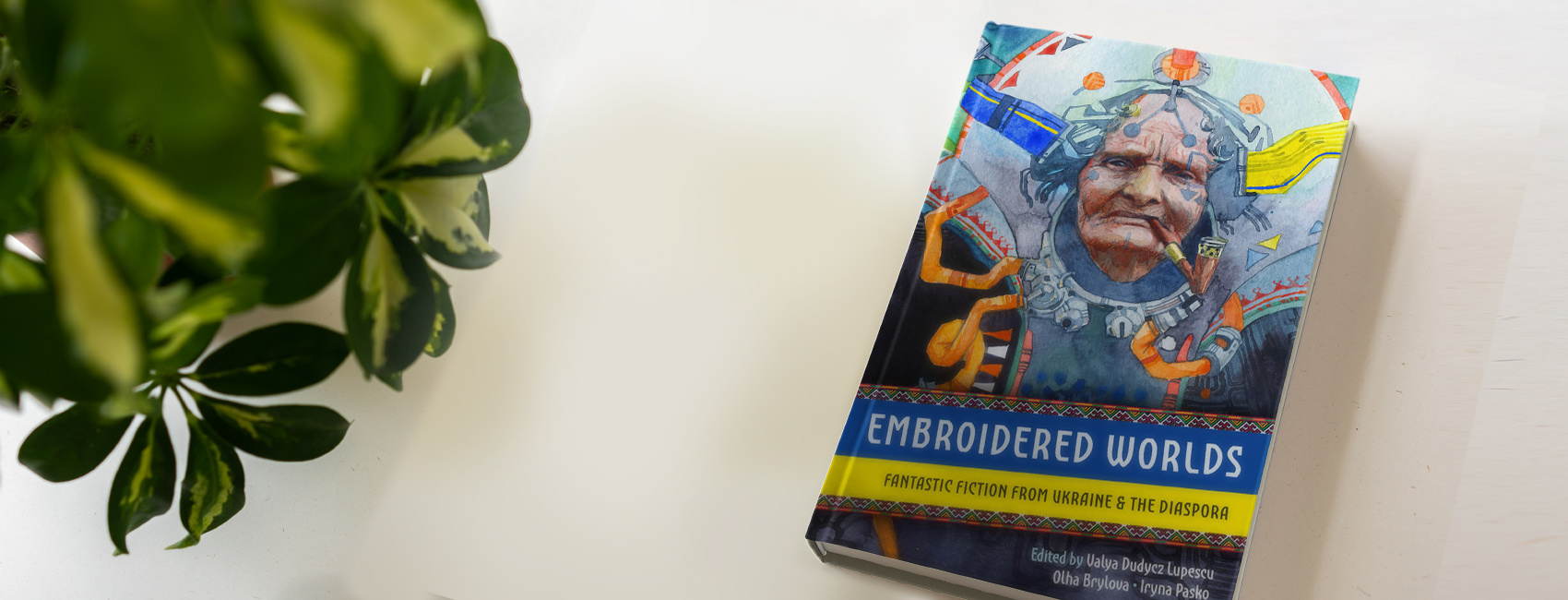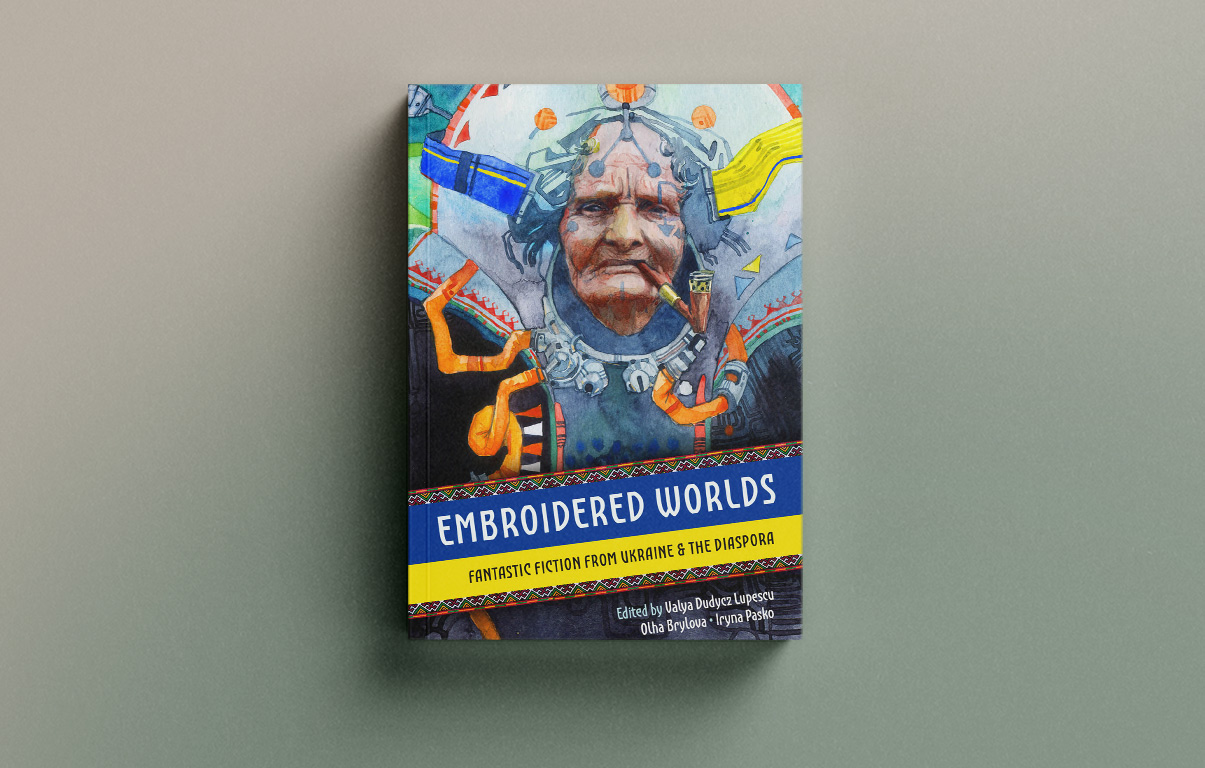* ESC - close the search window
FICTION
The Wild, Colorful, and Fantastic Realm of the Ukrainian Imagination — A Review of ‘Embroidered Worlds: Fantastic Fiction from Ukraine and the Diaspora’
19.04.2024
“Embroidered Worlds: Fantastic Fiction from Ukraine and the Diaspora” is a unique, comprehensive contribution to the ever-growing realm of Ukrainian literature available in English. First, it is unique because the publisher, Atthis Arts, held a large, online fundraiser in order to fund the book’s publication. Second, it gathers 30 stories from writers living in wartime Ukraine, as well as stories from writers of Ukrainian heritage. Last, but certainly not least, it presents a strong overview of Ukrainian science fiction, fantasy, horror, slipstream, and reimagined fairy tales.
Because of the diverse backgrounds of the writers featured in the collection, as well as the broad thematic spectrum the stories cross, the anthology is bold, thoughtful, and genre-redefining in its exploration of old worlds, new universes, current day terrors, and mind-bending surprises of wonderment and awe.
The anthology features well-known writers such as Yuriy Vynnychuk, A.D. Sui, Ostap Ukrainets, and Eva Berniczky whose writings have been known and respected both in Ukraine and elsewhere. It also features writers of Ukrainian heritage such as Arrowsmith Press founder Askold Melnyczuk and Valya Dudycz Lupescu, one of the anthology’s editors. The collection not only spans geography by featuring writers from all across Ukraine, Canada, and the United States, but it spans generations. Young Ukrainian writers, like Vasyl Dukhonovskyi who was born in Kyiv in 1994, offer readers a multitude of works by a new generation of post-Soviet Ukrainian writers embracing Ukraine’s sovereignty and democracy.
The collection opens with an important introduction by Valya Dudycz Lupescu. Lupescu poses a substantial question: “What is the value of a story?” To this question, Lupescu offers a valuable answer: “If you live in a place that has often been under attack or under conquerors, a land whose people keep having to fight for their freedom and the right to exist, it is not difficult to understand the appeal of fantasy and science fiction, of mysteries and ghost stories.” Thus, the stories featured in Embroidered Worlds offer readers an escape, a new version of reality, and a new means of processing the horrors currently unfolding in Ukraine.
Olha Brylova and Iryna Pasko contemplate another equally important question in the anthology’s second introduction “Does It exist?” One of Brylova’s Russian colleagues once asked the question, “Ukrainian science fiction and fantasy? Does it even exist?” Brylova explores how writing in Russian primarily established the disconnect between the reality that Ukrainian science fiction and fantasy existed and the Russian imperial mindset that “everyone writing in Russian was, well, Russian.”
Brylova and Pasko also point out another key idea important for readers, and particularly those who previously understood little about Ukrainian literature, that
“there were Ukrainian writers who write in Ukrainian, and translators who translated into Ukrainian — but they did not exist in my [Russian] colleague’s bubble.”
Brylova and Pasko’s exploration of language, identity, and the politics that surround these concepts in the pre-2022 Russo-Ukrainian literary and publishing fields reinforces the historical dichotomies between the two cultures. More significantly, Brylova offers readers the cardinal idea, too, that anthologies like Embroidered Worlds are paramount at this time because they reinforce the idea that, in Ukraine’s long-standing struggle for cultural and linguistic recognition on various global stages, Ukraine and Ukrainians everywhere will win.

The anthology harbors many notable stories. It opens with Yuriy Vynnychuk’s fantastic short story “An Embroidered World.” In it, the speaker observes how his grandmother’s embroidery has the power to alter the world around them. At its core, it is a moral story — an exploration of what gifts and talents an individual possesses can be used to either help or harm those around them and ultimately themselves.
Readers also find A.D. Sui’s “Svitla” to be a dramatic, heartbreaking story about a mother’s love and devotion as she navigates her existence with a daughter whose energy is more powerful than the radiation polluting Chornobyl. Sui’s story not only explores the emotional, psychological, and even physical complexities of a mother’s relationship with her child or children, but it is also a call for a return to nature via transformative respect, acceptance, and understanding.
N.R.M. Roshak’s “A Bitter Thing” blends dark humor with relevant socio-cultural discussions about identity, immigration, and otherness. Uniquely, it is set in America. Readers meet Ami, a young, overworked, and financially stressed gas station worker, and their relationship with Teese, an otherworldly creature known as a hexie. When read closely, the story initially serves as an allegory for modern immigration and acceptance of others despite their differences. Teese and his fellow hexies experience racism and discrimination because of their otherness. Teese struggles to navigate life on Earth and American-style capitalism’s expectations, and as he pursues ways to help Ami with their finances, Teese embarks on a dark, morally questionable path that unleashes a series of disastrous consequences for him and Ami. The story also surveys other American social burdens such as crippling student debt, dismal professional and economic prospects for immigrants due to restrictive immigration policies, and the often extreme means to which American workers resort to in order to earn an adequate living.
David Demchuk’s “Three Forest Tales” is a gripping, folklorish contribution that relies on familiar Ukrainian folklore figures such as the rusalka and the Baba Yaga-like Bone Mother. Brief yet powerful, these three tales offer readers who enjoy darker literature a healthy offering of psychological, even environmental, horror. In the first tale, titled “Krisztina,” a mother drowns her daughter after the mother learns that the daughter is pregnant with a fish. The second tale, “Luisa,” follows young Luisa’s journey of discovering her babcia’s true identity. Meanwhile, Luisa also discovers the curse with which she must live for centuries until a successor appears and their kind can “live anew.” “Nicolai,” the story’s third and final installment,” uncovers the fine lines separating humans from animals and harkens to the Scottish selkie folklore with which readers may be familiar.
Elizabeth Bear’s “Lest We Forget” opens with the stark, psychologically tantalizing line “I am dying of the war, though not in it.” The story thematically resonates with current discussions about the effects of PTSD on the general Ukrainian population because of the current war in Ukraine. However, the story also takes a moral approach to how one not only experiences war, but also processes it once it ends. The speaker continually describes war as a “contagion,” one that exists in every human being.
Askold Melnyczuk’s “A Brief History of the Little: People” is a humorous, folklorish exploration of acceptance, otherness, and coexistence. The speaker lives with a family known as “The Little: People.” The Little: People might remind those familiar with Ukrainian folklore of the domovyi, the house spirit who will protect a family as long as the family leaves food for the domovyi. The Little: People in Melnyczuk’s story, however, are socially and politically aware, and their presence in the story juxtaposes the rather rigid social and political rules by which humanity lives.
For example, the narrator discusses how the Little: People are inclusive and long ago incorporated those who identify as LGBTQ into their society. Interspersed between the narrator’s adventures with the Little: People are narratives depicting a US president who “insulted every person of color to ever walk the earth” and a “billionaire pedophile” who hangs himself in his cell. Other inherently American issues, such as “a white man wielding an AK-47” who “killed more than twenty people in El Paso,” appear in the story and make the narrator’s experiences with the Little: People seem more real than the actual current events portrayed in the news.
The story effectively bends reality and surrealism so that they bleed together and cause reader’s to question the state of one of the world’s most powerful nations whose Congress, for months, has held up aid to Ukraine.
RELATED: There Is Land Beyond Perekop – a Crimean Bildungsroman
However, not all of the stories in Embroidered Worlds leave readers feeling dismal and hopeless about the world’s state of being. The collection concludes with Volodomyr Arenev’s “To the Garden.” The story explores the necessity of historical memory in the face of history repeating itself. It incorporates elements from the current war, such as the word “orcs,” that make the story feel more immediate. Nonetheless, it is the story’s final, beautiful image that reminds readers about the power of maintaining hope: “They walked on together, holding hands. The snow drifted down, and the star shone, and somewhere behind them, up there, the garden waited patiently for them.” This return-to-nature theme echoes those in A.D. Sui’s “Svitla,” ultimately establishing a cyclical structure in the anthology.
Embroidered Worlds is also the perfect title for such an anthology. One can view Embroidered Worlds much like they would a traditional Ukrainian rushnyk. While each embroidered symbol and section bears its own symbolic, cultural, or even familial significance, it is when the rushnyk is viewed in its entirety that its magic and beauty are truly unleashed. Bold and brave, its stories are a testament to the role of storytelling and remembering in Ukrainian culture. More so, Embroidered Worlds is a reminder to the world that Ukrainians do, and always will, exist.
Copy Editing: Terra Friedman King
This publication is sponsored by the Chytomo’s Patreon community
the more you read, the greater the possibilities




